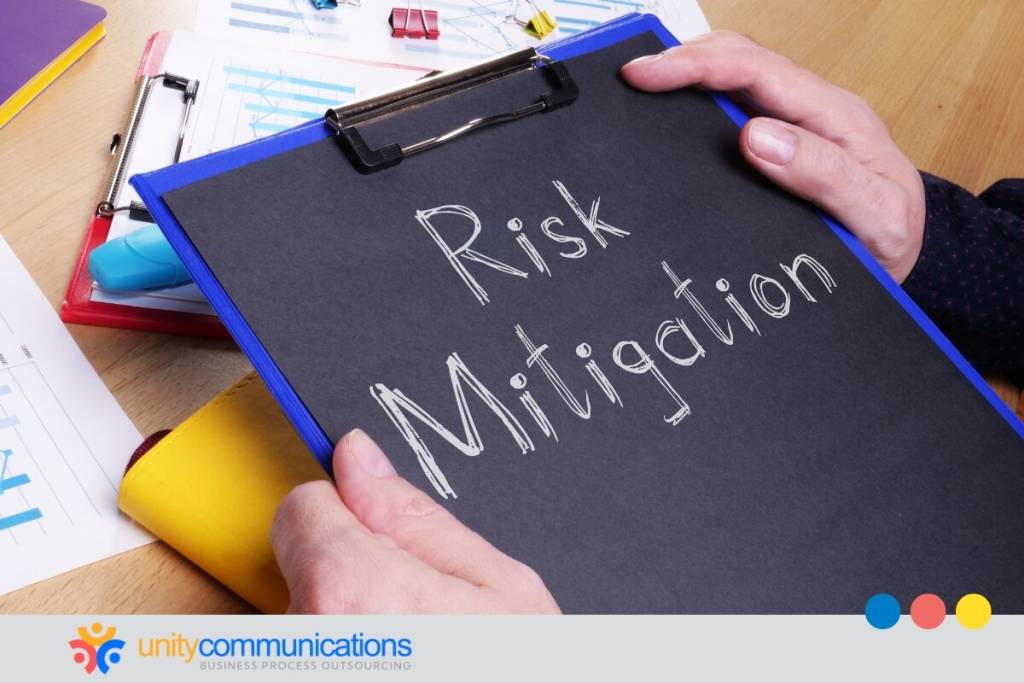Table of Contents
Business process outsourcing (BPO) operations face many risks, from data breaches to operational disruptions. Navigating these challenges requires robust frameworks and strategic approaches, such as establishing comprehensive security protocols and leveraging advanced technologies.
This article examines these BPO risk mitigation frameworks, exploring innovative strategies to safeguard operations against potential threats. It also covers the essential tools and methodologies for fostering resilience and sustainability in the ever-evolving realm of outsourcing.
Strategies for risk mitigation in BPO operations

BPO operations are susceptible to risks ranging from data breaches to operational disruptions. Robust risk mitigation frameworks safeguard the company against such threats, ensuring business continuity and protecting sensitive information.
Besides protection, they build trust and credibility among stakeholders, enhancing the reputation of BPO providers. Effective risk mitigation strategies also empower organizations to anticipate and proactively address potential challenges, bolstering resilience and sustaining growth in a competitive landscape.
What is the BPO company’s responsibility in managing risks? BPO firms can employ several strategies to manage volatility and uncertainty effectively.
These include the following:
Cultivating varied services and clients
A mixed roster of clients and services is essential for BPO companies to mitigate risks and capitalize on growth opportunities. Thus, they conduct market research to pinpoint industries needing outsourcing services. They analyze trends, competition, and client requirements to spot diversification opportunities.
Service providers also customize their services for specific industries or niches. They segment their market based on industry, size, geographic location, or needs. Additionally, they develop targeted marketing and sales strategies to attract clients from different segments and diversify their portfolio.
Finally, many BPO providers enter or expand to new international markets and reach different client segments. For example, they establish a presence in emerging regions with increasing demand for outsourcing, such as Latin America.
Implementing robust data security measures
The BPO industry saw an unprecedented surge in cyberattacks in 2021, resulting in financial losses surpassing $10 billion. Implementing robust data security measures is necessary for BPO companies to uphold client trust and protect sensitive information.
This process begins with a comprehensive risk assessment to identify vulnerabilities and threats. Data classification is crucial in ensuring sensitive information is protected through strict access controls and encryption protocols.
Access control mechanisms, including role-based access and encryption technologies, bolster security by limiting data access to authorized personnel and encrypting information at rest and in transit.
Network security measures such as firewalls and intrusion detection systems protect against external threats, while physical security protocols secure access to data storage facilities. An incident response plan maintains client confidence in the BPO company’s ability to safeguard sensitive information. It outlines the steps for promptly containing and mitigating breaches.
Diversifying geographic locations
Diversifying geographic locations helps leverage market opportunities. BPO companies identify strategic locations that offer a favorable business environment and access to critical resources. They consider client proximity, the availability of a skilled workforce, cost competitiveness, political stability, and ease of doing business.
Additionally, service providers form strategic partnerships or alliances with local businesses, industry associations, or government agencies in target markets. Maximizing their expertise, networks, and resources helps facilitate market entry and navigate regulatory requirements.
BPO firms also comply with each jurisdiction’s laws, regulations, and industry standards. They take time to thoroughly understand legal and regulatory requirements related to data protection, labor practices, taxation, and intellectual property rights.
Implementing real-time data analytics
Real-time data analytics is an essential part of a BPO risk mitigation framework. Establishing a reliable infrastructure to manage big data is the initial step. It involves investing in scalable cloud platforms, high-speed networks, and data storage solutions that can handle information from various sources.
Next, BPO firms integrate cutting-edge analytics tools into the infrastructure for real-time data analysis. They deploy machine learning (ML) algorithms, predictive analytics models, and streaming analytics platforms that can process real-time data, providing immediate insights and actionable intelligence.
Customizing dashboards and visualization tools is crucial to presenting real-time results in a user-friendly manner. They enable stakeholders to interpret data trends quickly, identify anomalies, and make decisions based on business conditions.
Developing a business continuity plan (BCP)
A risk mitigation framework also includes a comprehensive business continuity plan that outlines procedures for maintaining essential operations during disruptions. This plan includes identifying critical functions, establishing alternative work arrangements, and implementing communication protocols to coordinate responses effectively.
BPO companies set up redundancy measures and backup systems to minimize the disruption’s impact on operations. They build redundant information technology (IT) infrastructure, choose backup data centers, and create alternative communication channels to ensure uninterrupted service delivery.
Lastly, they establish clear incident response protocols to guide employees in responding to operational disruptions. They define roles and responsibilities, establish communication channels, and conduct regular drills to test the effectiveness of response plans.
How BPO providers design risk mitigation frameworks

In 2022, 41% of companies reported facing three or more significant risk incidents. Addressing these issues in BPO requires integrating effective risk mitigation frameworks into daily operations. This process demands a coordinated approach across the organization, with BPO long-term planning being crucial for developing robust strategies.
BPO firms can follow the steps below to design a comprehensive risk mitigation framework:
- Identify risks. Know the risks that can affect BPO operations. Examples include data breaches, service disruptions, regulatory non-compliance, and geopolitical instability.
- Assess risks. Evaluate the potential impact of each identified risk with techniques such as matrices or qualitative/quantitative analyses to prioritize problems based on severity and likelihood.
- Define risk tolerance. Establish acceptable risk tolerance levels for the organization, especially across different areas of operations. This process sets clear boundaries for risk-taking and informs decisions.
- Develop risk mitigation strategies. Manage BPO operations risks with tailored strategies. These include enhancing data security protocols, diversifying service offerings, implementing redundancy measures, and establishing contingency plans.
- Allocate resources. Dedicate enough financial, technological, and human resources to implement risk mitigation strategies effectively. These assets must be available to address high-priority risks and maintain risk management activities.
- Implement controls. Decrease the likelihood and impact of identified risks. Set up security protocols, conduct regular audits, enforce compliance standards, and establish monitoring mechanisms.
- Monitor and review. Develop a process for ongoing monitoring and review of the risk mitigation framework. Regularly assess the effectiveness of implemented controls, monitor changes in the risk landscape, and update the framework when needed to address emerging threats and vulnerabilities.
- Host training and awareness programs. Provide training and awareness programs to employees to ensure they understand the risk mitigation strategies and their roles in implementing them. Foster a culture of risk awareness and accountability across the organization.
- Draft SLAs. Include risk-related clauses in service-level agreements (SLAs) with clients and vendors. Define expectations regarding risk management responsibilities, incident reporting procedures, and liability allocation to ensure alignment with risk mitigation goals.
The bottom line

BPO providers can mitigate common risks with solid data protection, diversified services, real-time data analytics, and a comprehensive BCP.
By seamlessly integrating BPO operations and risk mitigation frameworks, companies can enhance resilience, minimize disruptions, and build trust with clients and stakeholders, ultimately contributing to long-term success and sustainability.
Let’s connect if you want to learn more about Unity Communication’s outsourcing solutions.




